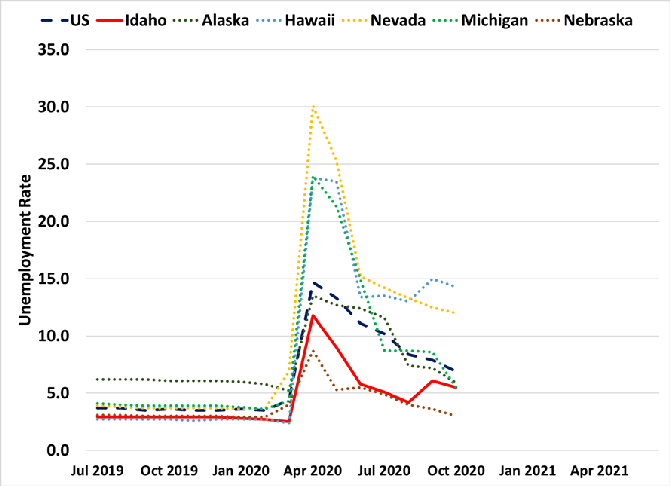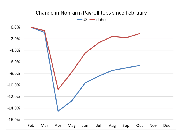Idaho economy still on road to recovery

Idaho’s unemployment rate jumped to a record high of 11.8 percent in April. By October, Idaho’s seasonally adjusted unemployment rate had fallen to 5.5. percent — lower than the U.S. rate of 6.9 percent. Source: Idaho Department of Labor
Idaho has recovered faster than most other states after economic losses caused by COVID-19 — but things aren’t back to normal just yet.
Though some assume Idaho’s relative success is because pandemic-related shutdowns were less strict than in other states, that paints an incomplete picture, according to Samuel Wolkenhauer, the Idaho Department of Labor’s northern region economist.
Wolkenhauer pointed out that some states that had no stay-home orders during the spring, such as Iowa and South Dakota, have not bounced back like Idaho. This suggests that lockdown measures were not the leading factor in economic recovery.
“I think a lot of it has to do with the willingness of Idahoans to spend money and go to work, even during a pandemic,” he said.
COVID-19 has changed many aspects of daily life. At least one long-term change could benefit the area economically.
More employers are becoming open to permanent telework, which makes it possible for some workers to relocate from more congested tech hubs, like California and western Washington.
Idaho has qualities that make it attractive to teleworkers, Wolkenhauer said: natural amenities, comparatively low cost of living, overall high quality of life.
“Now you can live here and you don’t have to sacrifice your job,” he said. “We think our region can pick up a lot of those high-earning professionals who are going to be working remotely.”
Moving marketplace HireAHelper reported in November that 194% more people have moved into Idaho than left the state since March.
“People thought Idaho was the place they wanted to be when the pandemic started,” he said. “That’s been a nice little economic shot in the arm throughout the year.”
Idaho’s long-term population growth has meant growth, not just stability, in construction. This has also increased the demand for real estate and mortgage services, creating jobs in the financial activities sector.
Manufacturing has also grown, Wolkenhauer said, with about a thousand jobs added in the Coeur d’Alene area since October 2019.
“That has to do with manufacturers that are still interested in locating here,” he said.
Conversely, leisure and hospitality jobs in the Coeur d’Alene area are down by about 19 percent compared to 2019.
“It’s by far the biggest drop of any industry,” Wolkenhauer said. “That’s even with a lot of recovery since April.”
It will take time for economists to definitively determine the state has recovered.
Though the unemployment rate is an important indicator, it can be misleading in a time like this, Wolkenhauer said, because it doesn’t necessarily account for people who dropped out of the labor force due to concerns about contracting the virus or due to a lack of childcare.
Women have been disproportionally affected in this area, Wolkenhauer said.
A study from the National Bureau of Economic Research found that working women are experiencing the worst effects of the COVID-19 recession.
More women have lost their jobs because industries with a higher concentration of women — including retail, hospitality and health care — have been hardest hit, according to the study. Fewer women than men have jobs that allow them to work remotely.
Also, when the pandemic forced the closure of daycare centers and schools across the country, it became harder for many women who do the bulk of childcare to continue working.
This could change as the COVID-19 vaccine is distributed and schools reopen.
“In 2021, we’re hoping to see a lot of women return to the workforce,” Wolkenhauer said.
Though North Idaho has made significant strides so far, Wolkenhauer said employment and labor force participation are still down overall.
As of October, 26,400 more Idahoans were unemployed than in February, according to seasonally adjusted labor force statistics from the Idaho Department of Labor.
Wolkenhauer noted that economic recovery is about more than returning to how things were before the pandemic.
“We want to catch up to our growth rate,” he said. “There’s still growth to do in 2021 to catch up to where we want to be.”












